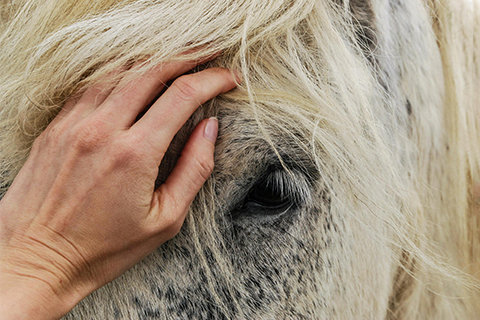
As a massage therapy student, I remember our anatomy instructor introducing the concept of fascia by comparing it to the pith of an orange—a continuous web that both connects and separates the pulp within each segment.
This was in the early days of conversations about the role and function of fascia, and even then I already felt I had a deep appreciation of this system. By then, I had spent over 15 years working on dogs and horses and the occasional zoo animal. Horses, in particular, had drawn me into the electrifying energy of a rippling fabric, neither skin nor muscle, evident just beneath the skin. Due to their tendency to sleep upright and their evolution for swiftness, the musculature of the horse had an affinity to the bone unlike other animals, and between skin and bone, the pulsing of energy was, well, palpable.
Few images provide a better visual representation of the harmony and fluidity that fascia lends to movement than that of a horse at a full gallop.
Animal Fascia is Different
From a fascial standpoint, the horse is unique for a number of reasons. For one thing, horses employ an intricate system of balance in the limbs called the stay apparatus, which allows them to stand and even sleep with minimal muscular effort. Thanks to a pulley system created by the linkages of muscle, tendon, and ligament, the carpal bones and the stifle (the joint that closely resembles the human knee) lock in place to prevent the horse’s massive body from causing the long lean legs to collapse when at rest.
Secondly, lacking a clavicle, the horse has no articulation joining the forelimb and the body. The front limb is suspended alongside the body by muscle, tendon, and ligament. As fascia expert Thomas Myers might say, those structures are merely filling in the spaces formed by the continuous fascial web that connects them like so many water balloons. As a result, the range of motion available owes much of its grace and agility to the “pre-stresses” created by the fascial matrix.
Additionally, fascia forms a direct relationship in the horse from the hyoid bone under the tongue to the single digit of the hoof on which the horse stands. Evidence of the tremendous counterbalance achieved by this fascial relationship was revealed in a necropsy study of thoroughbred racehorses, in which the majority of horses studied who had sustained injuries to the tendons or ligaments of the lower limb also had evidence of fractures in the hyoid apparatus.
In recent years, anatomical evidence about fascia in horses has led to new approaches to relieving tension and restoring mobility for animals of all types. Here is one example of how I was able to use myofascial release for my equine client.
Myofascial Release in Practice: A Case Study
Lexicon was an Irish show-jumping champion and a breeding stallion. His rider was concerned about back pain the horse began exhibiting during a critical period of their show season. Various diagnostic tests showed there was no obvious injury or clear explanation for the horse’s pain, and his response to having his sacroiliac joints treated with an analgesic agent was minimal. His behavior began to change as well, including kicking out while being ridden and refusing to jump high vertical obstacles. I had worked on other horses for this rider and eventually received a call to see Lexicon. I worked closely with the veterinarian involved and the groom responsible for the horse’s care.
Stallions can be tricky and Lexicon was no exception. One thing that struck me while assessing the horse was that he was constantly busy with his lips and tongue, rolling his tongue into the side of his mouth and drawing his lips forward and back. His handler confirmed he had been doing that for some time and that he assumed it was just stallion behavior. The rider added that he had been grinding his teeth at times when bridled. The muscles of his jaw and back of his skull were taut and sensitive, and the base of his neck went rigid under pressure. He had adopted a slightly bent posture through his neck, and the muscles on his left side were noticeably larger than the right. I used a combination of myofascial release and massage on the horse’s front limbs and chest to release the myofascial kinetic lines. I also worked over the temporomandibular joint on the left side. I was rewarded with some long yawns and blinking, classic signs of tension release in horses.
His breathing slowed and I was able to continue working into the groove between his mandible and the delicate bones of the hyoid apparatus. Intraoral work on horses can be a feat, but at the end of his massage, Lex allowed me to gently ease his tongue out of the right side of his mouth and apply a gentle traction. The space between his mandibles seemed to expand and loosen. After a long walk and a good roll in his paddock, he was given a day of rest. The following day, he was ridden lightly. His rider noted none of the grinding and a softer, steady feel in his hands, indicating a softness in the horse’s mouth that had not been there before.
A week later came the real test as they began preparing him for his next show. The kicking and resistance were gone. After three sessions, Lexicon returned to his previous level of jumping with no sign of back or neck pain.
Myofascial release for animals is an effective technique for addressing a variety of issues that can’t seem to be resolved elsewhere.




